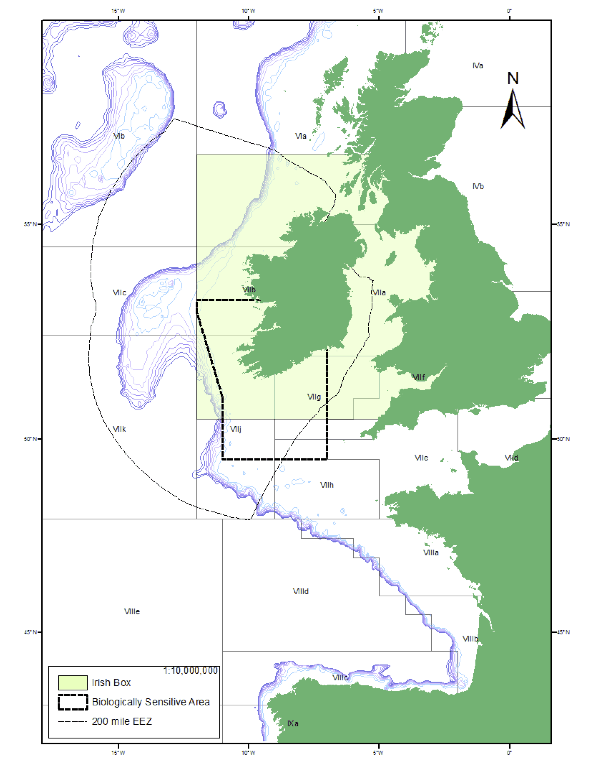Case Studies
Biologically Sensitive Area

Fig. 2. The Biologically Sensitive Area in the Celtic Sea including the Irish Exclusive Economic Zone and the continental slope. (From EC Request - Review of the Biologically Sensitive Area/Irish Box)
The continental shelf off the southwest coast of Ireland is an important spawning area for many commercially important species especially mackerel, horse mackerel, blue whiting, hake, megrim herring, haddock and cod. In 2003 a biologically sensitive area was established off the southwest coast of Ireland with the boundaries being decided upon mainly in a political context whilst considering areas with high concentrations of juvenile hake.
While this area is deemed especially important for hake nursery it does not correspond exactly to nursery grounds for other fish as their grounds are found further to the west along the continental slope. Nevertheless it is still an important nursery area for anglerfish, mackerel and horse mackerel, a spawning and nursery area for herring, whiting, and haddock, a spawning area for megrim and cod and includes a large area of nephrops ground. The area also has important stocks of scallops, brown crabs and spider crabs. The development of thermal fronts and phytoplankton blooms in the spring time are important for the growth and development of larvae species in the area.
Ireland is the most significant fisher in the area followed by France and Spain. The French and Spanish fleets have been found to focus their fishing efforts along the continental slope to the west and around the Goban Spur. Management measures in the BSA focus on reducing discards, protecting spawning areas, increasing the use of environmentally friendly fishing gear and establishing protected areas. Limits on the demersal fishing effort and an increase in the mesh size for towed and fixed gear are some measures that have been introduced. The implementation of the management measures has not been entirely successful due to poor communication of changes in regulation and the necessary recording of effort needed to determine the regulations was poor due to low compliance. The biomass of hake, megrim and anglerfish has increased in recent years although it is unclear how much the management measures have contributed to this as the boundaries of the BSA do not always match the spawning and nursery grounds of the stocks.
The Beaufort Research team is using the Biologically Sensitive Area as a test-case to look at the success of using ecologically meaningful boundaries in management. The boundaries of the BSA are not prohibitively strict as they need to consider the co-existence of key-species, bathymetric and other environmental variables which define a 'fuzzy' box with a useful degree of biological homogeneity. The behaviour of marine mammals is also an important focus in the area.
For more information see:
EC request - Review of the Biologically Sensitive Area/Irish BoxMarine Institute - Biologically Sensitive Area
Proposal from KFO to manage crab effort in the Biologically Sensitive Area
Study Areas